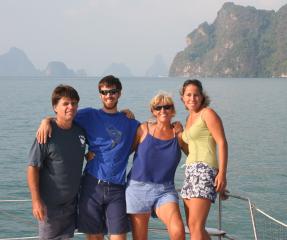
Still smiling after all these miles! 2007
Ocelot's crew in Phang Nga Bay, Thailand
by Sue Hacking (with contributions from Jon and Amanda)
 Still smiling after all these miles! 2007 Ocelot's crew in Phang Nga Bay, Thailand |
We’ve been cruising with teenagers for over 6 years now, and in the cruising community, that's a long time. Not only is it a long time, but we are a rare lot. Of the more than 150 cruising kids we’ve met during these years, only 50 have been teens – and many of those had just turned 13. Why are families with teens so rare out on the ocean? Or to re-phrase the question (recently asked us by British cruising friends) -- How has Ocelot managed to stay out cruising so long with teenagers on board? I think it boils down to three main issues: high school arrangements, providing stability and continuity, and making a family commitment.
Schooling
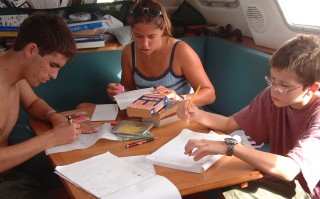 French for Chris & friend Nick (Lady Starlight), Spanish for Amanda. Studying in Tonga 2004 |
One of the main reasons we've seen other cruising families bury the hook when their kids reach 13 or 14 is that they feel they must be home for high school. While it's true that many countries do not recognize home schooling, per se, there are alternatives such as distance learning programs or the Cambridge program that allows traveling kids to study for the British "A" levels and sit exams overseas. Our home state of Washington is very pro-active in terms of home schooling, so it was easy to make arrangements for the kids' high school. For the first two years Amanda stayed connected with her Environmental School in Kirkland, while Chris enrolled with The Westbridge Academy, an umbrella school for college-bound home schoolers around the world. Chris writes more about his schooling experience, and I have something about boat schooling and college applications under Sue's Logs.
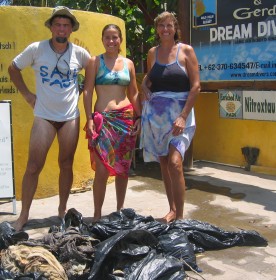 An Indonesian clean-up dive counted towards marine biology & volunteer time |
One thing we liked was that the schools agreed the trip itself is part of the education. The kids can't help but learn about the different cultures and peoples that we meet, and that all "counts". Indeed, it's one of the main reasons we're out here. It seems silly to us when we see boat kids with a regimented curriculum studying, say, ancient Greece when they're in French Polynesia. We study the areas we're in, which lends much more relevance to the studies. (The kids are responsible for the demographic and history sections of this website, in addition to their impressions of each place we've visited.) Subjects like marine biology (learned from university-level text books), oceanography and navigation are all valid and relevant high-school studies while cruising. If some of this sounds too "soft", consider that Chris, by self-teaching for 3 years, was admitted to some of the top engineering schools in the States, and passed Advanced Placement Exams in 4 subjects that jumped him 2/3 of the way through his first year of university. We think it works.
We also have no "weekends". That is, the kids don't get let out of school just because it's Saturday. We have lots of days the kids can't do traditional school (because we're sailing, or taking an inland tour or excursion, etc.) so when they can study, school is in session, at least in the morning.
We were lucky that the kids both knew how to study by the time they moved on board, so we've not had to do much "teaching." We give them books and they chew through them, handing us exam answers or essays for us to grade now and then. Lots of cruising families we've seen have a problem switching from "parent" to "teacher," but by letting the kids study at their own pace we avoided much of that stress.
Providing Continuity and Stability
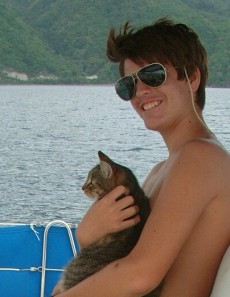 Home is where the cat is |
"Home is where the heart is" may be a cliché, but we believe it's true. Despite having sailed three oceans and making landfall on four continents we have kept our family and family life together. Sadly, we've seen some cruising families fall apart or give up the sailing life because they've not managed to offer stability to the kids. It's the not moving, per se, that unsettles teenagers, but a feeling of being out of control of their lives. Here are some things we did that worked for us:
We kept our house and stored our land-life belongings so as not to uproot the family. We thought it was important to keep ties to the life the kids knew so that it was easier for them to let go without feeling like they were in free-fall. Some cruising families have sold it all, moved aboard, and live in a perpetual state of statelessness – looking for someplace else to settle. That insecurity must be very unsettling. We may move a lot, but we feel stable.
We encouraged the kids to stay in touch with friends back home and new cruising friends they've met along the way. Before leaving we had Chris and Amanda study for their HAM radio licenses – a requirement before being able to send/receive email from the ship’s radio. While not strictly necessary (only one of us needed the license to receive for the whole family) it was a way of having the kids earn the "right" to use the on-board communications. In port we budget time and money at internet cafes for the kids to use things like Skype and Instant Messaging to stay in touch. We’ve seen other families try to cut their kids off from old friends ashore – a big mistake in our book as the yearning for those friends seems to make for discontented and rebellious teens.
|
|
Part of staying in touch was having the kids' best friends and their families down to visit on the boat. To do that, we made sure we bought a boat big enough to host guests, but see more about that below...
We budget time and money to travel back "home" every few years. This allows the kids to assess what it is they are missing (or not missing) and what it is (like freedom and respect) that they have on the boat but not ashore. They get to spend time with old friends, re-experience a bit of traditional school, and maybe put to rest those thoughts of “I wish I could be back there for the ….” Our kids also recognized that they are treated more like adults in the cruising community than they are in the States. We, and other cruisers who return, have found that short visits (no more than 4 or 6 weeks) are good, but longer ones mean the kids get re-entrenched into life ashore, and returning to the boat becomes harder and harder.
We set a realistic goal of cruising for no less than one year, hopefully two or more, and to cross the Pacific Ocean. The goal, while flexible (all cruising plans must be flexible), allowed the kids to feel the "edges" of the experience, to know where we were going. We never "threatened" them with cutting the trip short or turning back, and after one year we discussed, as a family, the pros and cons of carrying on.
Which leads to the most important issue, which is making a family commitment to cruise.
Involving the Family
The family commitment is perhaps the most important, and the most complicated ingredient in successful cruising with teens. Jon and I (having cruised in the 1980's) were already interested in taking the family cruising. We wanted to show the kids something of the world, to give them a sense of responsibility that can only come with ocean sailing and international travel, and to give them a perspective on other cultures and ways of life that they wouldn't get living in suburban USA. But these lovely ideas are useless if you can't bring them to reality. We've met many sailing families where the dream they are living is the parents', or one parent's, dream. We knew we had to concentrate on involving the kids.
We eased the kids into the idea of cruising more than a year before we left. Jon found himself between jobs in the summer of 2000 so we took the family to New Zealand and Australia for nine weeks of car touring. One of our stops was with friends who own Queensland Yacht Charters in Airlie Beach, Australia. We took one of their monohulls out for almost 2 weeks of sailing the Whitsunday Islands to see how the kids would fare. Up went the sails, the boat heeled over, and Amanda freaked. Although she adjusted to it after a few days, we let her know that, because of her response, we'd only consider multihulls (which don't heel significantly). Although Jon and I were already pretty sure we wanted a multihull (our first boat was a trimaran) it gave Amanda a sense that we cared for her comfort, and that she had some input to the decision making process.
During that short charter, and for the next few weeks as we toured the Queensland coast, we talked as a family about what kind of boat we wanted, what sort of equipment it should have, the pros and cons of various designs, how it would all work, etc. This engaged the kids and got them asking questions, generating a bit of excitement about cruising. It also gave them a sense of ownership and participation, and trust that their thoughts and feelings were important to us and would be taken into account when the final decisions were made.
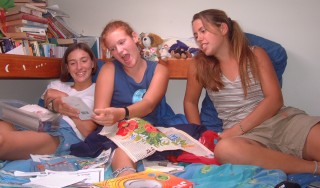 1 cabin and 3 friends = good fun Jo (Gambit), Avery (Delos), Amanda 2004 |
We involved the kids in the planning of the transition from land to boat life. We've heard of some families in which the parents make all the plans and the kids carry on with school and normal life, then Wham! they're hauled off to sail away. Chris and Amanda, at 12 and 14 had a big say in the kind of boat we wanted, the things we were going to take and leave (including the favorite family cat, who came!), the things that needed doing before leaving and what we had to buy for the boat. They researched things like watermakers, inverters, solar panels, school programs, sources for sails, etc. That all took one year, during which time our dining room looked like some sort of bizarre headquarters.
We bought a boat with an extra cabin. One of the things we discussed with Chris and Amanda when making The Boat decision was the number of cabins it should have. At home, the kids each have their own bedroom (although they share a bathroom) and we have a guest room always made up for visitors. The kids needed to know that their friends (and probably whole families) could come visit us, which meant we'd need a guest cabin in addition to our 3 cabins. Luckily catamarans, especially ex-charter catamarans (about the only kind we could afford), generally have a cabin in each corner. So the teens could have their half of the boat, and the adults the other.
Of all the problems voiced by cruising families, it's the hassle of shared cabins that comes up the most often. Teens need privacy, a place they can call their own, where they can put their stuff and retreat to when the world gets to be too much. We let our kids know that the boat would have to be sold eventually and asked them not to make permanent "decorations" but otherwise their rooms were their own.
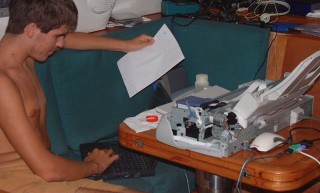 Chris (15) repairs the damaged printer |
We treat the teens as part of the crew. That means giving them challenges and helping them rise to meet them. Right from the beginning of our time on Ocelot we involved Chris and Amanda in scraping, sanding, taping, painting and waxing the boat on haul-outs. They learned to make fiberglass repairs, understand and trouble shoot the ship’s electronics, how to navigate and how to plot Ocelot's position on a chart, how to use the radios, and to make technical drawings for new parts. We taught them to sew, and to splice ropes, how to change the diesel engine oil and fuel filters, how to varnish and care for woodwork. This also helped teach them responsibility, and what's involved in caring for the boat. Their daily chores included caring for the cat, cooking, and galley clean-up. They drove the dinghy more than we did, and took the helm, handled the anchor and trimmed the sails every time we moved the boat. When we started making passages they stood night watches, made navigation and sail trim decisions, used the radar and communicated with ships as necessary. They arrived on Ocelot as complete sailing novices and within one year both were full crew members.
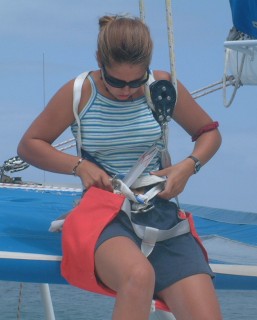 Amanda (13) preps to go up the mast |
But just expecting kids to take on responsibilities is not enough; as parents we had to guide, teach, re-teach, and be open to the talents and interests of our teens. Even though Chris preferred the electronics and computer work, and Amanda preferred the sail handling and rope work, they both had to participate in all aspects of cruising. As parents we had to make sacrifices: jobs took longer and sometimes things broke while the kids were learning. I did months of galley work: both teaching cooking and then doing dishes because I held to my promise that whoever cooked didn't have to clean up, but both kids became very good cooks. It helped that their schools allowed credit for navigation, "boat economics", oceanography, applied physics and other things relevant to cruising so that we could always hold out the "carrot" of "learn to do this and you'll get more credits towards high school graduation". At 13 and 15 they were standing full night-watches by themselves. At 17 Amanda began skippering Ocelot occasionally to build up credit toward her Ocean Yacht-Masters certificate.
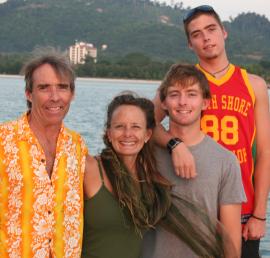 The Dreffin Family from Scud -- another family that made it work! |
We try not to abuse our power as parents/captain. As engineer and captain, Jon makes the decisions that involve our safety, and together he and I make decisions involving finances. But beyond that we try to include the kids in decision-making. Everyone has to compromise at times, but the long-term goal is to help the kids learn to make their own (hopefully sensible) decisions, so the balancing act is worth it. Even big decisions like where to sail became family events: After French Polynesia Jon and I wanted to cruise the Cook Islands, but the kids had been months without other teens so we skipped all the Cooks and made for Tonga where we cruised for five months with other families.
We adjust our schedule to maximize time with other cruising families, especially those with teens. Recognizing that happy kids make for a happy boat, we tried to balance our (adult) needs and the needs of Ocelot (repairs, etc) with staying together with other teen boats. It was always surprising to find some families that ignored the needs/wants of their teens and took off to isolated anchorages or made few efforts to socialize. We have loved meeting other families who cruise with teens, and the other moms and I especially enjoy sharing our thoughts and experiences -- all the while knowing the "kids" are having fun together.
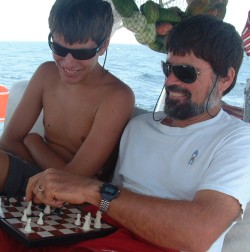 Chris & Jon battle on the chessboard |
We all had to learn better communication skills. Day-to-day living in close confines (sometimes for weeks while on passage) is tough, and we all get grouchy. We’ve had our arguments and yelling matches, of course, but fewer and fewer over the years. No one gets away with being in a bad mood, rude, or bossy for very long without being called on it. And blue teenage funks get talked through if possible, or left alone to dissipate if necessary. We've all had to learn to be more understanding, to apologize, and to forgive. We've also learned that there are certain lines that can't be crossed, certain things that can't be "un-said" later, when living in close confines. Families unwilling to try to communicate better, or parents who insist on the authoritarian model, will have a tough go of it aboard a cruising sailboat.
We had to be patient. There's lots to learn about on a cruising boat, and lots of adjustments to make when living in close quarters. It actually took almost a year for the kids to fully engage the cruising lifestyle. During that time there were many family discussions, some quite heated. It took time for all of us to learn to respect each other, to give each other the space and consideration that's so important on a small boat (and all cruising boats are "small"). And all four of us still are learning to let each other evolve and change.
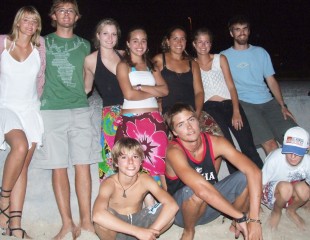 Good friends 12 to 21 on a Thai beach 2007 From Mahi Mahi, Scud, Ocelot, Vamp & Anon |
We have lots of fun. Life isn't all serious, and while instilling responsibility in our teens was part of the goal, so was enjoying life. As a family we joke, laugh, and tease each other a lot. I can act goofy and silly with Amanda and her good friends, like Rachel. Jon and Chris have shared hours messing with the computers and playing computer games or chess. Amanda and I enjoy DVD movies together for relaxation, and we share each other’s love of guitar, singing, and fiction writing. We all revel in the travel to new places and enjoy the new foods, the different customs and languages and the beautiful scenery so unique everywhere we go. As a family we love to hike, snorkel and scuba dive together. And the kids have formed some wonderful life-long friendships from our years on the sea.
Cruising wasn't Jon's dream, or my dream. It wasn't a dream at all, really. It was a goal that we worked towards as a family. It has been a dance of changing priorities, balancing the needs of one with the wants of others. We must be doing something right on Ocelot because Amanda and Chris have both opted to spend one more year on board after finishing high school, and Chris returned to cruise for 3 months with us in SE Asia in the middle of his university studies. We have, it seems, by-passed the rebelling teenage years and jumped to the delightful phase of enjoying each other as individuals and as friends. What more could we ask for?
All text and photos copyright Sue Hacking/hackingfamily.com 2007